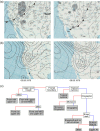Causative classification of river flood events
- PMID: 31423301
- PMCID: PMC6686718
- DOI: 10.1002/wat2.1353
Causative classification of river flood events
Abstract
A wide variety of processes controls the time of occurrence, duration, extent, and severity of river floods. Classifying flood events by their causative processes may assist in enhancing the accuracy of local and regional flood frequency estimates and support the detection and interpretation of any changes in flood occurrence and magnitudes. This paper provides a critical review of existing causative classifications of instrumental and preinstrumental series of flood events, discusses their validity and applications, and identifies opportunities for moving toward more comprehensive approaches. So far no unified definition of causative mechanisms of flood events exists. Existing frameworks for classification of instrumental and preinstrumental series of flood events adopt different perspectives: hydroclimatic (large-scale circulation patterns and atmospheric state at the time of the event), hydrological (catchment scale precipitation patterns and antecedent catchment state), and hydrograph-based (indirectly considering generating mechanisms through their effects on hydrograph characteristics). All of these approaches intend to capture the flood generating mechanisms and are useful for characterizing the flood processes at various spatial and temporal scales. However, uncertainty analyses with respect to indicators, classification methods, and data to assess the robustness of the classification are rarely performed which limits the transferability across different geographic regions. It is argued that more rigorous testing is needed. There are opportunities for extending classification methods to include indicators of space-time dynamics of rainfall, antecedent wetness, and routing effects, which will make the classification schemes even more useful for understanding and estimating floods. This article is categorized under:Science of Water > Water ExtremesScience of Water > Hydrological ProcessesScience of Water > Methods.
Keywords: flood genesis; flood mechanisms; flood typology; historical floods; hydroclimatology of floods.
Conflict of interest statement
The authors have declared no conflicts of interest for this article.
Figures





References
-
- Alila, Y. , & Mtiraoui, A. (2002). Implications of heterogeneous flood‐frequency distributions on traditional stream‐discharge prediction techniques. Hydrological Processes, 16(5), 1065–1084. 10.1002/hyp.346 - DOI
-
- Apel, H. , Merz, B. , & Thieken, A. H. (2009). Influence of dike breaches on flood frequency estimation. Computers and Geosciences, 35(5), 907–923. 10.1016/j.cageo.2007.11.003 - DOI
-
- Archer, D. R. (1989). Flood wave attenuation due to channel and flood plain storage and effect on flood frequency In Beven K. & Carling P. (Eds.), Floods: Hydrological, sedimentological and geomorphological implications (pp. 37–46). Chichester, UK: John Wiley & Sons.
-
- Ashley, S. T. , & Ashley, W. S. (2008). The storm morphology of deadly flooding events in the United States. International Journal of Climatology, 28, 493–503. 10.1002/joc - DOI
-
- Baker, V. R. (1998). Paleohydrology and the hydrological sciences In Benito G., Baker V. R., & Gregory K. J. (Eds.), Palaeohydrology and environmental change (pp. 1–10). Chichester; New York: John Wiley & Sons.
Publication types
LinkOut - more resources
Full Text Sources
